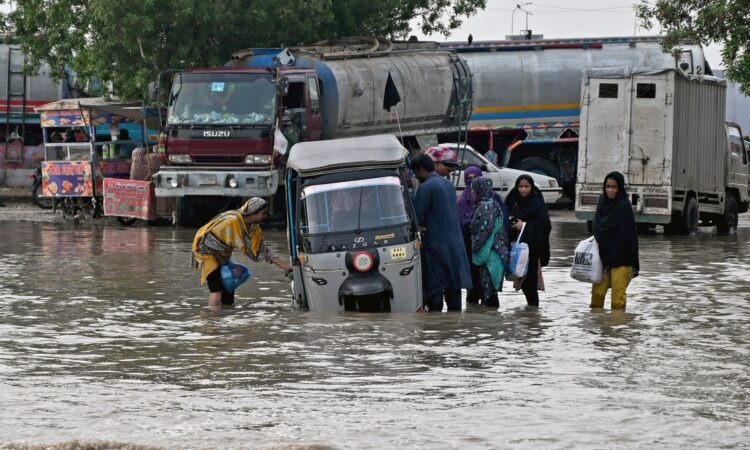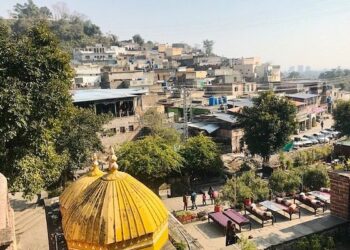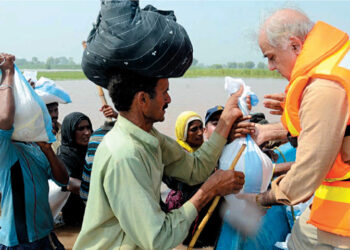KARACHI: Power supply was nearly restored and traffic movement began to resume across Karachi on Wednesday, though several underpasses and roads remained inundated after back-to-back spells of heavy rain battered the city. The death toll from rain-related incidents since Tuesday rose to eight, while the Pakistan Meteorological Department (PMD) warned that more downpours were expected in Sindh and Balochistan over the coming days.
Tuesday’s relentless showers overwhelmed Karachi’s already fragile infrastructure, bursting storm-water drains and choking sewerage lines. Several neighbourhoods reported waist-deep flooding, power breakdowns, and disruptions to internet and mobile services that lasted for hours. Business and industrial operations across Pakistan’s economic hub were also brought to a standstill. The situation forced the Sindh government to declare Wednesday a public holiday in the metropolis.
Fresh showers bring new warnings
By Wednesday afternoon, rainfall was again recorded in Saddar, Malir, Malir Cantonment, Scheme 33, Gulistan-i-Jauhar Block 2, I.I. Chundrigar Road, Kala Pul, and the Jinnah Postgraduate Medical College (JPMC) area. At 3pm, the PMD issued an alert forecasting thunderstorms with strong winds in most parts of the city within two to four hours. Some locations were expected to receive heavy downpours, with the Met Office cautioning of urban flooding. Citizens were advised to remain indoors and avoid unnecessary movement.
Karachi Mayor Murtaza Wahab also used social media to caution residents, asking them to avoid travel after 2pm. “If it starts raining, please stay put where you are — whether at your home or office,” he said. “We are expecting more intense rains.” Sindh’s meteorological spokesperson Anjum Nazir echoed the same concern, telling Reuters that further showers could be stronger than Tuesday’s spells.
Power supply and restoration work
Despite the chaos, power utility K-Electric said its generation, transmission, and distribution system remained stable, with over 2,000 out of 2,100 feeders functional by Wednesday afternoon. Spokesperson Imran Rana said restoration was under way in affected areas as rainwater receded. He urged the public to avoid electrical installations and exercise caution when using appliances. “In case of emergency complaints, please call the 118 helpline,” he added.
The utility confirmed power was being gradually restored in several localities, including Surjani Town, North Nazimabad, Gulshan-i-Iqbal, Korangi, and parts of Defence Housing Authority (DHA).
Traffic disruptions persist
The Karachi Traffic Police reported by evening that major underpasses remained closed, including those at Shaheed-i-Millat, Drigh Road, Nazimabad, Liaquatabad, Gharibabad, and Sohrab Goth. Korangi Crossing and EBM Causeway were also submerged. Motorists were advised to take alternative routes and call helpline 1915 in case of emergencies.
While the traffic department listed more than ten key points as flooded, Mayor Wahab posted contrasting footage on X showing major arteries such as Sher Shah Suri Road, Submarine Underpass, Shahrah-i-Pakistan, and Liaquatabad cleared of water. He acknowledged some bottlenecks but insisted drainage operations were ongoing.
Government and rescue response
Sindh Chief Minister Murad Ali Shah chaired a meeting to review the crisis, ordering round-the-clock drainage and rescue operations. “Municipal and emergency teams are on alert, with 26 de-watering pumps deployed to ease flooding,” his office said in a statement. Shah also visited Sharea Faisal and the Nursery area, where he told reporters that climate change was worsening rainfall patterns globally. “It is wrong to say the city drowned and the administration was absent,” he insisted, pointing to the continuous work of municipal staff and rescue teams.
The Pakistan Army also joined the relief drive, with PTV reporting that troops used heavy vehicles to tow stranded cars and shifted elderly citizens and children to safer locations. Videos posted online showed army personnel working alongside civil rescue staff in affected neighbourhoods.
Death toll rises to eight
Rescue 1122 confirmed two additional deaths on Wednesday, adding to six fatalities from Tuesday. Volunteers recovered the body of a 50-year-old man swept away in a nullah near Gurumandir and a 19-year-old motorcyclist electrocuted in DHA Phase 5. Separately, a man and woman were injured when part of an old building collapsed in Ranchore Line.
Earlier, four members of a family were killed in Gulistan-i-Jauhar when their house walls caved in. An eight-year-old child died in Orangi Town, while another young man was electrocuted in DHA.
Rescue workers also evacuated dozens of people trapped by floodwaters, including 30 employees from a call centre in PECHS Block 6.
Torrential downpour paralyses city
According to the PMD, Manghopir received an astonishing 235mm of rain in just 12 hours, far exceeding the city’s drainage capacity. Gulshan-i-Hadeed received 178mm, Keamari 173mm, Jinnah Terminal 156mm, North Karachi 149mm, and Defence Phase 7 around 138mm. Even traditionally less-affected areas like Orangi Town and Korangi recorded between 80mm and 140mm.
The sudden deluge submerged Karachi’s main arteries, including Sharea Faisal, M.A. Jinnah Road, and I.I. Chundrigar Road. Commuters were stranded for hours, with hundreds of cars and motorcycles submerged in waist-deep water. Domestic and international flights at Jinnah International Airport were delayed, diverted, or cancelled as runways became waterlogged.
Officials stress climate change challenge
Mayor Wahab, addressing a press conference, said the intensity of rainfall demonstrated the reality of climate change. “You can criticise the administration, but the truth is that climate change is a challenge for every government and state in the world,” he remarked. He compared Karachi’s torrential rains to those witnessed in Khyber Pakhtunkhwa, Islamabad, and northern areas in recent weeks.
He explained that the city received two major spells on Tuesday — the first ending by 9:30am, which allowed drainage, but the second lasting from 1:15pm until the evening, flooding the city again. “Our nullahs are built for 40mm capacity; with over 200mm falling, overflow is inevitable,” Wahab added.
More rains forecast in Sindh and Balochistan
The PMD warned that strong monsoon currents from the Arabian Sea and Bay of Bengal would continue to affect southern Pakistan. Widespread rain-wind-thundershowers with heavy falls were predicted in Karachi, Hyderabad, Thatta, Badin, Mirpurkhas, Umerkot, Sanghar, and Jamshoro until August 22. Balochistan districts including Gwadar, Kech, Panjgur, Khuzdar, and Lasbela were also likely to face torrential rains, raising risks of flash floods.
Provincial disaster management authorities were advised to remain on high alert, with warnings of urban flooding in low-lying areas of Sindh, including Karachi.
As Karachi’s residents cleaned up from one deluge while bracing for another, officials and experts reiterated that only climate resilience, improved drainage systems, and behavioural changes could protect the city from recurring monsoon catastrophes.

























